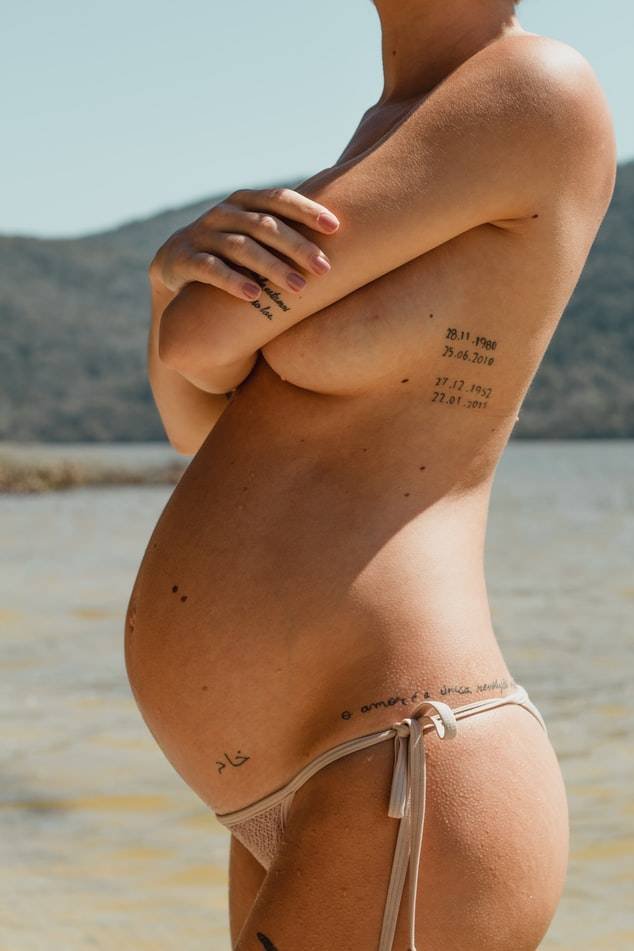
Moving through the birth canal on a journey into the world is our first experience of meeting strong physical resistance. In order to be born, the baby literally has to squeeze through the narrow tunnel of Mum’s pelvis. Baby’s skull is only partly formed and is an amazing balance of protection and pliabilty. Being pliable helps the baby through the birth canal and accomodates the strong forces that are experienced during birth.
At birth, baby’s head is unfused bones to allow for enormous changes in shape. Between the bones where the membranes meet are soft areas called fontanelles. There are large fontanelles at the front, the back and the sides of the baby’s head. The fusion of these bones takes place by about seven years of age.
As the baby’s head passes through the birth canal, it’s squeezed into shapes that fit the contours of the mother’s pelvis. These strong forces can continue for several hours during labour. These forces are very important in awakening the baby in preparation for it’s entry into the world and initiating the second process of ignition, baby’s first breath.
The nature of our birth is one of the most significant experiences of our lifetime, as well as one of the greatest challenges. Many of the first stresses are resolved within the first ten days as the baby’s healing processes come into play.
Sometimes, stresses from birth can become inertial patterns that can affect the health and create difficulties. Common symptoms can be
*difficulty feeding
*inability to suck or latch
*colic
*excessive crying
*irritability
*poor sleep
*developmental problems
*emotional distress
*ear or sinus problems
Birth trauma can also influence how the baby moves. This may be asymmetrics of motion or strong prefence to one position, eg. baby only likes to feed on one breast, suggesting some neck strain. The patterns of motion adopted by the baby mirror the movement that occurred during its birth. Whether or not a baby has a traumatic birth and remains traumatised is determined by a number of factors: some may be under the control of parents and caregivers and some aren’t.
Shape and Size of Mum’s Pelvis
Some pelvic shapes are easier to birth through than others. If the mother’s pelvis is very narrow or more triangular in shape, the baby may have more of a difficult time navigating it’s way through. With some pelvic types, a caesarean section may be necessary. A baby born through caesarean section doesn’t undergo the compressive forces of natural delivery. The baby’s head doesn’t go through the moulding as it passes the birth canal. A caesarean delivery produces sudden changes in pressure from the environment of the womb to the outside world and may shock the baby with it’s quickness. With an emergency caesarean the baby may be traumatised by the complications of a difficult labour.
Size of The Baby
Babies vary in size, the larger the baby, the more difficult some labours may be. The average baby weighs about three kilos, some babies may be up to five kilos.
Position of Baby
The position of the baby as it passes through the pelvis also determines the ease of delivery. Certain positions make for easier exit. The easiest postion is head first. Less strain is caused on the baby when its in anterior presentation. The baby’s face moves down the mother’s sacrum as it passes through. Ideally, the baby’s chin is tucked against its chest, creating the smallest diameter for it to pass down the birth canal. A difficult delivery for baby is to be born breech, where the baby comes out bottom first. This causes forces to enter the baby’s body from the bottom up, and it’s hips and pelvis take the strain. The baby’s head doesn’t go through the benefits of proper moulding.
During a Biodynamic Craniosacral therapy session for baby and for mother, details of the pregnancy and birth will be important to the practitioner and give valuable clues to the origin of any symptoms. As many of the problems of early trauma are treatable, if only every baby was checked by a Craniosacral Therapist at birth or soon after.
Treatment For Babies and Children
The systems of babies andd children are very finely balanced and delicate, as well as deeply intelligent. A Biodynamic Craniosacral Therapist applies plenty of care and sensitivity with the babies and children responding quickly to the treatments.
Treatments for Mothers
Mothers benefit enormously from treatments supporting rebalancing after childbirth. Biodynamic Craniosacral Therapy can help resolve strains in the pelvis or sacrum, returning the pelvic bones to their normal positions and to ease any residual lower back pain. Pains, pulls and strains that affect the mother’s nervous system can contribute to tiredness and post natal depression. Sometimes the uterus can become malpositioned from giving birth, a sensation that causes a dragging pain in the pelvis. These patterns are often helped by Biodynamic Craniosacral Therapy.
Working with Mothers and babies is one of the most rewarding aspects of Biodynamic Craniosacral Therapy. It’s particularly a joy to see the progress of infants as they increase their levels of integration, presence and aliveness. To see them become dynamic, engaged and thriving in their beingness.
Blog post from wisdominthebody.org
Fb page Wisdom In The Body
biodynamiccraniosacraltherapy #craniosacraltherapysunshinecoast #birth #sunshinecoastbirth #sunshinecoastantenatal #pregnancy #prenatalcare #postnatalcare #sunshinecoast #wisdominthebody #malenyholistichealth

